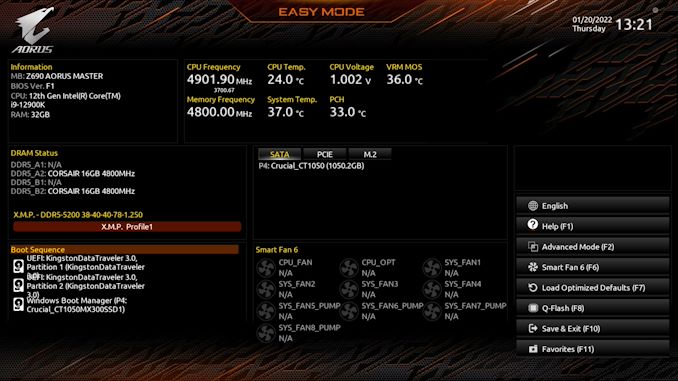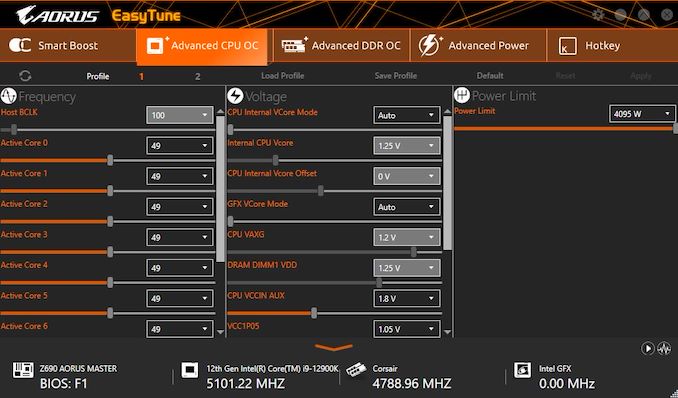The GIGABYTE Z690 Aorus Master Mobo Review: 10GbE Rounds Out A Premium Board
by Gavin Bonshor on February 25, 2022 9:00 AM ESTBIOS
The GIGABYTE Z690 Aorus Master is using its typical Aorus themed UEFI BIOS, which we've seen many times over the last few years. The GUI uses orange highlights, with a primarily black background and white text. It uses an orange highlight to depict which option is selected. The GIGABYTE UEFI firmware also has two modes for users to choose between, the 'Easy' mode and the 'Advanced' mode.
Upon entering the firmware for the first time, which can be accessed by pressing either the Del or F2 Key during post, it will revert to the Easy mode. Users can see a basic list of hardware installed within the Easy mode, including information on the processor, memory, and fans installed onto the 4-pin headers. Users can also enable X.M.P 3.0 profiles on supported kits of memory, see basic information on temperatures from different sensors such as CPU and VRMs, and view current CPU VCore voltage.
Users can access the Advanced mode by pressing the F2 Key. The Advanced mode opens up a whole host of settings and customizable options for users to tweak, fine-tune, and overclock their system. All of the board's overclocking settings can be found within the 'Tweaker' menu, with various options for overclocking the CPU, memory, and integrated graphics on supported Alder Lake CPUs.
The Advanced mode also allows users to customize the chipset-related settings, enable or disable non-critical controllers such as networking and audio, and access various platform and power management settings. By pressing the F6 Key within the firmware, users can access GIGABYTE's Smart Fan 6 utility, where the 4-pin fan headers can be assigned fan profiles or sync fan settings across all of the headers.
Overall, GIGABYTE UEFI firmware is easy to use, it's responsive to our USB keyboard and mouse. It has a large variety of customizable settings for users to sink their teeth into. There are plenty of avenues available to increase overall system performance, including extensive memory tweaking options, as well as plenty of options for overclocking both the P and E-cores on Intel's Alder Lake processors.
Software
When it comes to software, each vendor has its own software suite designed to energize and supplement its hardware offerings. GIGABYTE includes a wide variety of software applications, including its EasyTune software for overclocking within Windows and its System Information Viewer (SIV) utility for monitoring temperatures, voltages, and it also features its Smart Fan 6 automatic fan tuning utility.
As many vendors include with its motherboards, GIGABYTE has its own overclocking utility called EasyTune. The EasyTune software allows users to overclock the processor within Windows, including CPU frequency and allows users to customize primary voltages related to the CPU such as CPU VCore and CPU VCCIN. Users can even change the memory frequency ratio and customize the primary latency timings, although users doing this will need to restart their PC for settings to take effect.
The System Information Viewer (SIV) utility allows users to monitor system temperatures, voltages, and other things such as CPU core frequency. It also includes its Smart Fan 6 automatic fan tuner which optimizes fan speeds based on temperature and fan RPM, as well as the ability for users to create their own fan profile curves. Users can also set temperature and voltage alerts from a variety of integrated sensors throughout the board and various voltages from CPU VCore, CPU VCCIN, and on the 12 V, 5 V, and 3.3 V rails incoming from the power supply.
Other utilities within GIGABYTE's software bundle include its @BIOS utility, which allows users to flash the board's firmware to the latest, either from a file or via GIGABYTE's web server. The Aorus Game Boost is an application that allows users to 'optimize' system processes, while the RGB Fusion 2.0 software allows users to customize the integrated and attached RGB LED strips with various lighting effects and a color wheel.
Overall the software bundle with the GIGABYTE Z690 Aorus Master is befitting of a premium motherboard. As we've highlighted many times over the years, we wish motherboard vendors would bundle audio software as standard and not force users to download them from the Microsoft Store.


























35 Comments
View All Comments
thestryker - Friday, February 25, 2022 - link
I wish this had dual LAN and used the 2.5gb Intel chip as the secondary. I'm sure the Marvell 10gb is likely fine I just prefer having the safety blanket of Intel as an option on all my PCs. Otherwise it seems like a winner so long as you're willing to drop that kind of money on a motherboard.This doesn't seem like a bad price for all of the stuff they've jammed in there, but it does highlight what I've noticed about DDR5 Z690 boards. It seems like they go from barebones to premium without much in between. On the DDR4 side there certainly seems to be a lot more in the middle ground which may simply be because nobody really put out high end DDR4 boards. Hopefully when RPL lands this won't be an issue for the corresponding new motherboards.
zepi - Sunday, February 27, 2022 - link
Intel 2.5Gb chip has been super buggy and many people have problems with it. There are multiple revisions of it and even third re-release still had bugs.Jp7188 - Friday, February 25, 2022 - link
I love big heatsinks, but this board takes it a little far. That m.2 sink is so tall and close to the vid card that the backplate on my card wouldn't fit. I had to cut down the m.2 sink to make it work, which is still preferable to no sink at all.Also, the VRM sinks are too tall to allow some cpu HSFs to fit. The notctua u12s clears the RAM but not the sink at the back of the board.
Jp7188 - Friday, February 25, 2022 - link
One other gripe, I can't get a trident z5 6400 kit to work above 6000. I checked gskill's qvl and sure enough this board is one of the few missing from the list. The board is listed on the qvl for gskill's slower versions of the z5.timecop1818 - Friday, February 25, 2022 - link
imagine overclocking in 2022Silver5urfer - Saturday, February 26, 2022 - link
Why what's the problem ? Like you want to spend on a K series processor and an XMP kit and a top of the line Z series chipset for X series for AMD but want to run in on Stock OOTB clocks ? That's gigantic waste of money. Because you would be better if you do not want to tinker with a H series board and a locked SKU, save money.As for OCing itself, it's a great thing. Since people can get fun out of their tweaking the HW that they own make it personal. And get maximum possible performance out of it. Like people are not just dumb Apple iclowns who just obey what Apple says, Goolag is pretty much same now. PC is the last refuge for owning something and making it purely personal. If you have an issue probably you should stick with Apple products or something like a Surface or some BGA trash.
PeachNCream - Monday, February 28, 2022 - link
It seems like that is a lot of additional cost to personalize something in order to fill what is mainly an emotional want inside of the space of recreational computer usage. So a want within a want in a world full of needs - it may be an unwise choice to do so.Silver5urfer - Monday, February 28, 2022 - link
PC is not just a gaming machine. If anyone thinks so they should discard their overpriced PC and get a Console for $500. It's not a recreational computer usage either. A PC - Personal Computer acronym says it all. It became more and more customizable for x86 until the junk BGA laptops came into the picture taking away the customization and DIY factor.timecop1818 - Monday, February 28, 2022 - link
I wouldn't buy a "XMP kit" in the first place unless it was somehow cheaper than plain Samsung dram on a green pcb from the likes of crucial or Samsung itself. i don't need disgusting rgb crap or giant fins on heatsink for what is essentially running memory ICs designed for 1.35V (or whatever) at much higher voltages just because "you can". of course, it will fucking heat up. normal dram operation doesn't need heatsinks.Jp7188 - Tuesday, March 1, 2022 - link
DDR5 is still in its infancy. It needs high voltage and heatspeaders to approach the latency of DDR4. The non-XMP 4800 CL40 is a joke, so it's high V and heatspeaders for the time being.